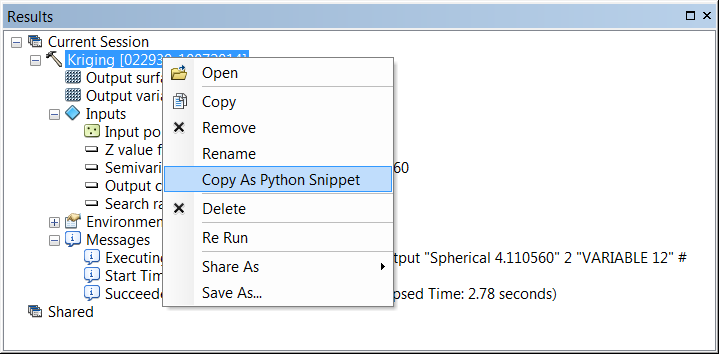- Home
- :
- All Communities
- :
- Products
- :
- ArcGIS Spatial Analyst
- :
- ArcGIS Spatial Analyst Questions
- :
- Re: automate kriging of multiple (120) layers
- Subscribe to RSS Feed
- Mark Topic as New
- Mark Topic as Read
- Float this Topic for Current User
- Bookmark
- Subscribe
- Mute
- Printer Friendly Page
- Mark as New
- Bookmark
- Subscribe
- Mute
- Subscribe to RSS Feed
- Permalink
Hello,
I am trying to find geographic patterns within pavement distresses at 70+ airfields across the continental United States. I have many layers that I have already completed spatial analysis on (manually). I had to change the values used to Krig from and would like to find a faster way to perform the Krig analysis using Python.
Bottom line:
I need to Krig 120 layers
I would like to use the first layer as a template for the remaining 119 layers because I need to change the parameters of lag size, # of classes, break values, and have it use the maximum of any coincidental points
Once created I would like to rename the Krig layer the same of the inputLayer + "Krig"
Any help would be great!! Thank you very much.
Solved! Go to Solution.
Accepted Solutions
- Mark as New
- Bookmark
- Subscribe
- Mute
- Subscribe to RSS Feed
- Permalink
2017-01-13 Updated script formatting
Alright...an example...just read it carefully
"""
krigingTest.py
Dan_Patterson.carleton.ca
requires: read carefully
see http://resources.arcgis.com/en/help/main/10.2/index.html#//009z0000006n000000
as well
"""
import arcpy
arcpy.CheckOutExtension("Spatial") #get the extension
from arcpy.sa import * #import all the frigging stuff
arcpy.env.overwriteOutput = True #make sure that you overwrite your feable attempts
input_shp = "C:/Temp/krige/pnts.shp" #input the shapefile name
arcpy.MakeFeatureLayer_management(input_shp,"temp") #create a temporary layer
for i in range(1,6): #run it in a range, make sure it isn't 0 for the start
cellsize = i #vary the cell size is being modelled *********
outname ="C:/Temp/Krige/test" + str(cellsize)
print ( "output grid: {0} cellsize {1}".format(outname,cellsize) )
#arcpy.gp.Kriging_sa("pnts","Z","C:/Temp/Krige/output","Spherical 4.110560","2","VARIABLE 12","#") #another example
#arcpy.gp.Idw_sa("pnts","Z","C:/Temp/Krige/IDW","2","2","VARIABLE 12","#")
# Do the work *****
arcpy.gp.Kriging_sa(input_shp,"Z",outname,"Spherical 4.110560",cellsize,"VARIABLE 12","#")
outRaster = Raster(outname)
outRaster.save()- Mark as New
- Bookmark
- Subscribe
- Mute
- Subscribe to RSS Feed
- Permalink
To get you started...do one manually until you get everything right, then go to the Geoprocessing Results window, right-click on the last process you did and copy it as a python snippet as shown in the figure. From there it is a matter of putting that within a loop fixing your output names as you go along.
# Replace a layer/table view name with a path to a dataset (which can be a layer file) or create the layer/table view within the script
# The following inputs are layers or table views: "pnts"
arcpy.gp.Kriging_sa("pnts","Z","C:/Temp/Krige/output","Spherical 4.110560","2","VARIABLE 12","#")
is the output from a simple default run with nothing else selected.

- Mark as New
- Bookmark
- Subscribe
- Mute
- Subscribe to RSS Feed
- Permalink
2017-01-13 Updated script formatting
Alright...an example...just read it carefully
"""
krigingTest.py
Dan_Patterson.carleton.ca
requires: read carefully
see http://resources.arcgis.com/en/help/main/10.2/index.html#//009z0000006n000000
as well
"""
import arcpy
arcpy.CheckOutExtension("Spatial") #get the extension
from arcpy.sa import * #import all the frigging stuff
arcpy.env.overwriteOutput = True #make sure that you overwrite your feable attempts
input_shp = "C:/Temp/krige/pnts.shp" #input the shapefile name
arcpy.MakeFeatureLayer_management(input_shp,"temp") #create a temporary layer
for i in range(1,6): #run it in a range, make sure it isn't 0 for the start
cellsize = i #vary the cell size is being modelled *********
outname ="C:/Temp/Krige/test" + str(cellsize)
print ( "output grid: {0} cellsize {1}".format(outname,cellsize) )
#arcpy.gp.Kriging_sa("pnts","Z","C:/Temp/Krige/output","Spherical 4.110560","2","VARIABLE 12","#") #another example
#arcpy.gp.Idw_sa("pnts","Z","C:/Temp/Krige/IDW","2","2","VARIABLE 12","#")
# Do the work *****
arcpy.gp.Kriging_sa(input_shp,"Z",outname,"Spherical 4.110560",cellsize,"VARIABLE 12","#")
outRaster = Raster(outname)
outRaster.save()- Mark as New
- Bookmark
- Subscribe
- Mute
- Subscribe to RSS Feed
- Permalink
Dan- Thank you very much for your help. I really appreciate you taking the time to consider my question.
- Mark as New
- Bookmark
- Subscribe
- Mute
- Subscribe to RSS Feed
- Permalink
No problem, good luck with your example